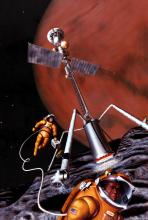Moon and Mars [1]
Walking across the largest moon of Mars might be quite a jolt. Mars would spread out just 3800 miles away. A strong jump could push you out into space. And the moon’s nightside might create electric shocks — not enough to hurt a person, but enough to damage equipment.
Phobos looks like a potato with a bite nipped off one end. On average, it’s about 14 miles in diameter — the size of a small city.
Escape velocity from the little moon is just 25 miles per hour — less than the top speed of sprinter Usain Bolt. That low gravitational pull could someday make Phobos a good spot for a base — it would take little fuel to land and take off.
But a trek across Phobos could create an electric charge. A study a couple of years ago found that a strong charge may build up on the little moon’s nightside — a result of the solar wind.
The wind contains particles with both positive and negative electric charges. But more negative particles may hit the nightside than the dayside. So anyone who walks across the nightside might build up a static charge — like walking across a carpet in your socks. Touching any metal could then cause a discharge — perhaps strong enough to damage scientific instruments or other equipment — a bit of a “jolt” on this odd little moon.
Mars is near our own Moon the next couple of mornings. The planet looks like a fairly bright orange star. It’s to the left of the Moon at first light tomorrow, and a bit closer above the Moon on Friday.
Script by Damond Benningfield
Keywords:
- Mars' Moons [3]
- Solar Wind [4]
- Space Exploration [5]


